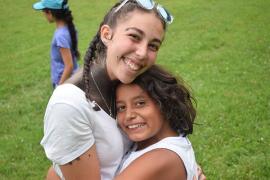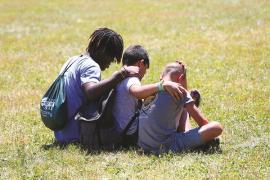Described as one of the world's foremost high-altitude mountaineers, Luis Benitez gives Camping Magazine a personal account of struggle, valor, and resilience as he rose above his own physical limitations to gain world-wide fame in a merciless sport that claims the lives of many and offers reward to a very few. The reward? The opportunity to stand on the summit of Mount Everest, the highest point on earth with a view of Tibet, India, and Nepal — all in one contemplative, sweeping glance through the mist, through the biting wind, and through the 29,038 feet of arduous struggle to reach your personal best.
On the south side of Mount Everest, near Nepal, at 17,600 feet sits a camp. It's not your usual camp. It's not filled with children and camp counselors nor does it sport a dining hall or cabins surrounded by woods. It's called the South Base Camp; it's primitive, cold, weathered, and occupied by Sherpas (a Tibetan people with over a 500-year history of honoring, according to their culture, the sacred mountain — Mount Everest) and mountain climbers. All climbers before attempting to summit the South East Ridge of Mount Everest will stay at this rudimentary camp acclimatizing to the altitude for up to several weeks. Here, among the Sherpas, known for their physical prowess in high-altitude environments, and climbers from all over the world, Luis Benitez makes himself temporarily at home. At this Base Camp, Benitez prepares physically and mentally to lead, along with another mountain guide, a twelve-member team to the summit of Mount Everest (29,038 feet) — this being one of six expeditions he has led to the summit of the tallest mountain on earth.
At Base Camp, one of the Sherpas, proud and strong, might have looked at the lithe and competent Benitez and wondered why this man would travel across the world to climb the sacred mountain. He may never know what compels Benitez to make the grueling climb, but Benitez knows exactly why.
Overcoming Adversity
He was two months old when he felt the first shiver in his lungs and experienced the first gasp for air. It was a sudden and fierce asthma attack. From that point, Benitez's childhood was plagued with rushed trips to the emergency room, doctor visits, strong medications, and a life of careful play indoors protected from possible allergens and any type of over exertion.
He longed for the big outdoors, and often his imagination would take him to the farthest points of the world as he poured over National Geographic and Scholastic magazines, which painted for him a picture of life beyond the walls of his home. After a decade of his childhood spent inside looking out at the active world around him, Benitez's parents took him to a new doctor who had a revolutionary idea to help Benitez's lungs grow strong. The doctor recommended endurance exercise such as swimming in indoor, chlorinated pools, and hiking in areas with high altitude.
Exercise and hiking, the activ ities his parents and he most feared, became part of a healing process that has remained with Benitez all his life. "I attribute my healing to my parents recognizing that I needed to be outside. When my family felt I was well enough, they took me to Camp Don Bosco in the Ozarks, which opened an entirely new world for me. I looked at the opportunity to be outdoors as a beautiful gift," remembers Benitez. "Where normal kids think it's natural to be playing outside, getting dirty, holding frogs, and being near a campfire, it was a gift for me. I was allergic to nearly everything even campfire smoke. So, being at camp and being part of all of those things I could never engage in before was a heady experience."
The Dream
Being outside to Benitez was "like walking on the moon." He says, "I never expected to play outside. I wasn't totally free to run and play. It took years for me to adjust. I always had the feeling of being cautious."
Moving from being a sedentary child to swimming on leagues and vigorously exercising was not a smooth transition for Benitez: "I would have asthma attacks during swim meets and be sent to the emergency room." None of these setbacks deterred him from pursuing his dream. That dream emerged slowly, almost imperceptibly, as he studied the exhilarating photos of expeditions to the summit of Mount Everest in National Geographic as a young boy and while he visited his grandfather's sporting goods store in St. Louis. With inhaler in tow, he would listen with rapt attention to store patrons swap stories of their adventures in the wild — all seeming so unattainable to him with his asthmatic condition.
Through his teen years, he would spend his summers with his father's family in South America where he would hike with a friend through the Andes Mountains. "I remember on one of those hikes seeing some guys rock climbing and thinking, ‘That's crazy, walking up a cliff on your hands and feet!'" says Benitez. "When I read about climbing Mount Everest, I thought it was a great place to start climbing, but that was impossible at my young age, so I adopted rock climbing at first. Because of the asthma, I couldn't play organized sports. Camping, hiking, and climbing were my releases. I gravitate to sports that are individual, reflective, and allow you to challenge yourself and compete against yourself."
At sixteen, Benitez turned his mountain climbing dream into a reality with his first summit of Mt. Cotopaxi (19,350 feet) in Ecuador. In 1992, he obtained an associate's degree in political science at the University of Missouri, St. Louis; however, his talent for mountaineering and the joy he found in mountain climbing continued. His dream soon became a career as a mountain guide and instructor with Outward Bound and Alpine Ascents International. Benitez is now one of the youngest and most gifted high-altitude mountaineering guides in the world; he has led multiple expeditions to six of the Seven Summits (Mt. Everest, Mt. Aconcagua, Mt. Denali, Mt. Kilimanjaro, Mt. Elbrus, Vinson Massif), the highest peaks existing on each of the seven continents.
Finding Teachable Moments
Teaching Youth
"When you are guiding people whether adults or children in extreme adventures, you are showing them that they can push past the preconceived boundaries. These days our youth watch so much TV they develop fears of the great unknown (the outdoors). Adventure activities teach children and youth that even though they may fail, they are up to the challenge," explains Benitez. "There is something to be said about getting up in the morning, climbing a small peak, and watching the sunrise. You don't get that from TV, and with children, there's very little gray zone, they love it (the outdoors), or they hate it, but they definitely remember it."
Benitez is a member of several boards of youth-serving organizations that inspire children, youth, and families to engage in outdoor activities. The primary goal, according to Benitez, is to help children and youth understand that being involved in the wilderness or camp experience teaches them that they are a small part in a bigger picture. It also builds understanding that you need to rely on others. "That's a huge lesson for youth. It's important when you are working with youth to help them understand their place in that bigger picture, and also to help them learn to stand up for what they believe in. When you are outside you may have an idea of what you should be doing, but nature tells you what you can do."
Recently, Benitez led a program at Cheley Colorado Camps for teenage leaders from around the country discussing the question: What does an effective leader look like? Benitez believes camp staff are perfect examples of leaders who have a deep level of experience and understand the difference between "talking" and "doing," much like the leadership skills he conveys on mountaineering expeditions. You can say to a camp leader, "Don't tell me what the book says; tell me what you know." He further explains, "There are heroes in camp leadership, retaining those heroes and having them be mentors to the next generation of camp staff is paramount."
Teaching the Corporate Professional
Not only does Benitez work with youth populations in teaching mountaineering and rock climbing, he reaches the corporate professional as well through leading professional development programs focused on challenge initiatives through Outward Bound. "I have discovered it's not the activity that you are participating in but the growth and learning the activity generates that is most important," states Benitez. "I enjoy taking people to another level, helping them realize that the things they thought were impossible are possible. I learned that lesson at an early age."
Benitez takes groups of corporate professionals to a mini-summer camp program focusing on leadership development through adventure activities with the strong belief that all the lessons learned at camp when he was a child are valuable and necessary in the professional world, in family life, and in the community. Benitez uses those teachable moments you find at camp, and interprets these lessons for working adult professionals. His lessons are simple: Have open, honest, direct communication; don't be afraid of failure; and have fun. These are lessons he uses in teaching and during expeditions for both adults and children.
Every mountain that Benitez scales becomes another poignant lesson that whether conquering Mount Everest or any of the highest points on earth, there is no greater feat than conquering your own personal Everest.
Originally published in the 2010 January/February issue of Camping Magazine.



